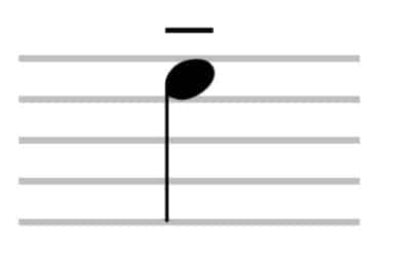Across piano music, there are frequently little lines scattered throughout written music notation and if they both were taken out of context, it would be impossible to tell the difference between the two. Fortunately the context of either one makes it really clear as to what they mean and how they impact the music.
The tenuto mark is the less common of the two and it is usually learned at an intermediate stage of learning to play the piano. It looks like this:

As you can see that it is directly placed above the note head when the stem is going down and inversely when the stem of the note is going up, the tenuto mark is placed directly under the note head. In some ways it can be a bit hard to describe using the written word however its definition is that it is to indicate that the note that is written above or below it needs to be played a little slower but not as slow as a pause (or fermata). Pauses momentarily affect the beat of a piece of music whereas a tenuto does not. Tenutos are sometimes interpreted as accents that give the note an extra ‘punch’ or ‘oomph’ but they not this either. Sometimes they are seen as a little pause and/or a little accent. The way I have both seen it done by classical piano players as well as the way I was taught to play them is that you play a tenuto by physically leaning into the note.
Ledger lines are used in most pieces of piano music and even though we might not have learned the name, we see them from learning to read the most basic of piano music. In fact we cannot perceive good old Middle C without seeing the ledger line that makes the note distinctive and easy to read as a beginner.
Ledger lines are the little lines that extend the musical stave (or staff) both above and below the treble and the bass clef. Without it we would have to find an alternative to indicating notes like Middle C and the notes that are at the extreme ends of the piano. Without ledger lines, we could be stuck playing on eleven notes in the treble clef and eleven notes in the bass clef (obviously with the help of sharps and flats we can add a few more notes than this, but not a whole lot).
Ledger lines with notes look like this:

As tenutos and ledger lines fulfill completely different functions, it is fairly easy to tell them apart because the number of ledger lines used at any given time is always the minimum that is required, so it will either be forming a little ladder up or down to the relevant note and the note that needs the ledger line will either have the head of the note touching the ledger line, like it is sitting on it , or the ledger line will go straight through the middle of the note head. In the case of the tenuto mark, the tenuto itself will never be touching the note (or if it does, the music has been badly printed).
Out of context, it could be argued that the ledger line and the tenuto look exactly the same, however the context and whether it is touching the note or not makes it really clear whether it is a tenuto or a ledger line.
